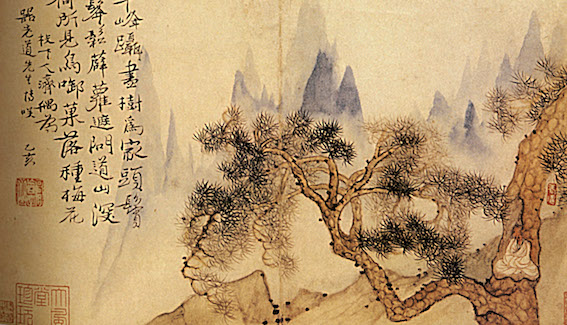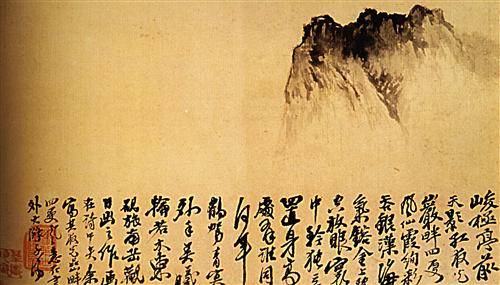SHITAO

Shitao, In meditation at the foot of the mountains impossible, 1695, ink and wash painting, Sichuan
There are two comparably structured ensembles in the oeuvre of Shitao (1642-1707): a consciously verbalized theory and a practice carried to extremes. The founding intentions are the idea that practice and theory should not be seen as two parallel entities, each of which is bound into a fixed harmony.
In Shitao’s ink paintings there are often forms of mountains and bodies of water that appear phantasmatic, the images of nature are linked with human urges. According to François Cheng this is not a naturalistic painting and even less an anthropomorphism to associate certain elements of nature as living forms with human character. The meeting between human beings and the universe is located on a more profound level than of exterior similarities.
According to the Taoist cosmological concept after the original chaos that preceded heaven and earth it was the primordial breath that dissolved and linked their unity at the same time. Instead of being seen as mere substance, every living being is considered above all as aggregation of different types of life breath, which rule over the vital functions of all things. In a complete analogy, Shitao translates those terms onto the level of painting. He uses “Chaos” in order to indicate the state that precedes the act of painting. The idea of primordial chaos is associated with the Yin and Yang. Here, in the connection of division and simultaneous complement, which in Chinese thinking is not conflicting, Shitao bases his concept of the ONE single brushstroke. The act of executing the first brush stroke is identical with the line that separates heaven and earth. They are connected through breath. Also a human being only becomes a human being with the act of breathing, with which he takes in the essence of the universe. As result of the brushstroke, the unity of brush and ink is to be understood as an analogy of heaven and earth, yin and yang. Through this collaboration of the two all figures of reality finally take shape in the painting. Painting is therefore not simply a description of the spectacle of the world order, it itself is a microcosm, the essence and functionality of which is identical with those of the macrocosm.
see: François Cheng. EMPTY AND FULL: Language of Chinese Painting. Boston 1994.

Shitao, The lonely mountain, 1707, ink and wash painting, Musée du Palais Carnoles, Menton